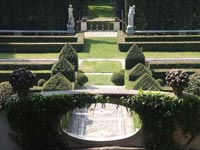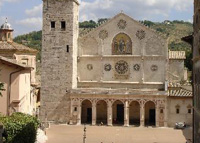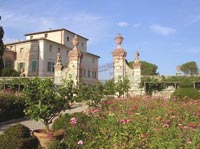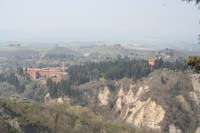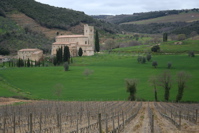| Domenico di Michelino, The Triumph of Fame, the Triumph of Time and the Triumph of Eternity, tempera on panel, gold ground, 42 x 177 cm, private collection |
Domenico di Michelino |
| Domenico di Michelino (1417–1491) was an Italian painter of the Florentine school and a follower of the style of Fra Angelico. He was born and died in Florence. Michelino predominantly painted scenes from the Bible. His most famous work can be found on the west wall of Florence's "Duomo" (cathedral) Santa Maria del Fiore, including La commedia illumina Firenze ("The Comedy Illuminating Florence"), showing Dante Alighieri and the Divina Commedia (Divine Comedy). Along with Dante and the city of Florence, the work depicts Hell, Mount Purgatory, the earthly Paradise (with Adam and Eve) and the celestial spheres. He took his name from his teacher, a carver in bone and ivory named Michelino. He was elected to the Compagnia di San Luca (painter's guild) in 1442 and joined the Arte dei Medici e degli Speziali in 1444. |
|
||
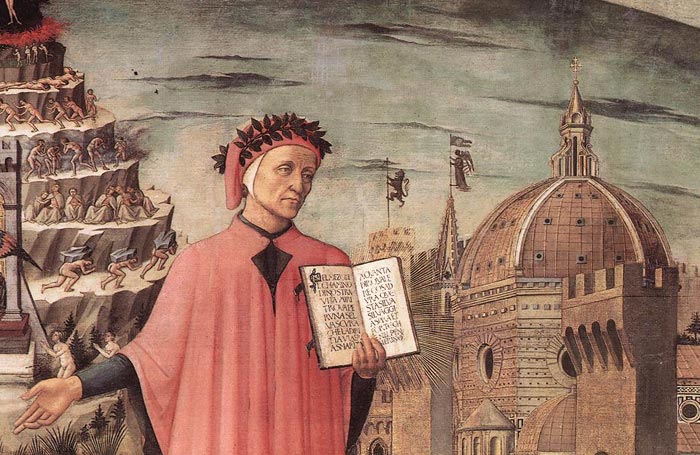 |
||
Domenico di Michelino, Dante and the Three Kingdoms, 1465, oil on canvas, Museo dell'Opera del Duomo, Florence |
||
The Divine Comedy describes Dante's journey through Hell (Inferno), Purgatory (Purgatorio), and Paradise (Paradiso), guided first by the Roman poet Virgil and then by Beatrice, the subject of his love and of another of his works, La Vita Nuova. While the vision of Hell, the Inferno, is vivid for modern readers, the theological niceties presented in the other books require a certain amount of patience and knowledge to appreciate. Purgatorio, the most lyrical and human of the three, also has the most poets in it; Paradiso, the most heavily theological, has the most beautiful and ecstatic mystic passages in which Dante tries to describe what he confesses he is unable to convey (e.g., when Dante looks into the face of God: "all'alta fantasia qui mancò possa" - "at this high moment, ability failed my capacity to describe," Paradiso, XXXIII, 142).
By its serious purpose, its literary stature and the range - both stylistically and in subject matter - of its content, the Comedy soon became a cornerstone in the evolution of Italian as an established literary language. Dante was more aware than most earlier Italian writers of the variety of Italian dialects and of the need to create a literature beyond the limits of Latin writing at the time, and a unified literary language; in that sense he is a forerunner of the renaissance with its effort to create vernacular literature in competition with earlier classical writers. Dante's in-depth knowledge (within the realms of the time) of Roman antiquity and his evident admiration for some aspects of pagan Rome also point forward to the 15th century. Ironically, while he was widely honoured in the centuries after his death, the Comedy slipped out of fashion among men of letters: too medieval, too rough and tragical and not stylistically refined in the respects that the high and late renaissance came to demand of literature. He wrote the Comedy in a language he called "Italian", in some sense an amalgamated literary language mostly based on the regional dialect of Tuscany, with some elements of Latin and of the other regional dialects. |
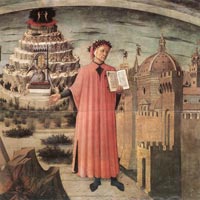 Dante, poised between the mountain of purgatory and the city of Florence, displays the famous incipit Nel mezzo del cammin di nostra vita in a detail of Domenico di Michelino's painting, Florence 1465 [1] |
|
In the painting by Domenico di Michelino Dante and His Poem the artist shows the three regions in the Christian afterlife. On the left is the procession of sinners being led down to the circles of Hell. Behind Dante the You can see the souls in hell eternally pursuing a banner. In Dante's poem he states these are souls that are constantly pursued by wasps that sting them continuously. Satan is depicted in Dante's poem as having three faces...one was in front, and each with a different color. It was fiery red. Satan is frozen in ice at the center of the earth according to the Dante poem. In the painting you see Satan as if he is in the midst fire and brimstone beneath the earth of the underworld. In Dante's underworld Satan is encased in ice because Satan is the antithesis of God. The mountainous structure behind Dante is Purgatory. As Virgil and Dante climb the mountain, they find seven cornices on which penitent sinners get cleansed by God's grace. The gate of Purgatory is guarded by an angel who is shown as an inset in the center of the cornices. The Angel uses the point of his sword to draw the letter "P" (signifying peccatum, sin) seven times on Dante's forehead.Dante must make his confession before he can be admitted through the gate. There are seven sinful tendencies, which hinder man from being in the full harmony and will of God. These seven levels of purgatory correspond to the seven deadly sins. The artist has depicted these levels of Purgatory very well. Each level of purgatory purges a particular sin in an appropriate manner. Souls move upwards since the intent of Purgatory is for souls to ascend towards God in Heaven.
|
||
| The first level of Purgatory is where the sin of pride is punished. Those guilty of pride are shown carrying giant stones on their backs. These souls are unable to stand up straight.
The second terrace is where envy is punished. The souls have their eyelids stitched shut. The wear clothing that makes the soul indistinguishable from the The fourth terrace is where sloth is punished. Those who were slothful in life can only purge this sin by being zealous in their desire for penance. The fifth terrace is where greed as well as the prodigal is punished. Penitents lay face down confronting their attachment to earth-bound materialistic pursuits. . It is here that the poets meet the soul of Statius who has completed his purgation and joins them on their ascent to paradise. The sixth terrace is populated by those guilty of gluttony are purged by abstaining from any food or drink. To sharpen the pains of hunger, the former gluttons on this terrace are forced to pass by cascades of cool water without stopping to drink. The seventh and final terrace is for those guilty of lust. They are purged by burning in an immense wall of flames All of those who committed sexual sins, are purified by the "red ring of fire" depicted in the painting. Dante now sees souls in burning fire. Virgil tells him that he must enter into the flames that burn but do not consume. This is his final cleansing and now Virgil's guidance and instruction come to an end as they reach the top of the mountain At the top of the mountain they find the Garden of Eden. Adam and Eve are the two figures present on the top of the cornices in the painting. The bands of color for Heaven radiate truth, goodness and gentleness. The primum Mobile is the outermost sphere revolving around the earth. "Within the depthless deep and clear existence of that abyss of light three circles shone- three in color, one in circumference; The second from the first, rainbow from rainbow; the third, an exhalation of pure fire equally breathed forth by the other two. In the night sky shine three stars, faith, hope, and charity" |
||
| Dante and Virgil, reach the top of the mountain. Lady Beatrice meets them there. Virgil mentions Lady Beatrice throughout the poem to encourage Dante. Lady Beatrice prepares Dante for his journey to Heaven. With Beatrice at his side, Dante get ready to go up to the peak of Mount Purgatory to the first of the heavens. Dante moves upward through the spheres. Within each sphere there are the redeemed, perfected, and glorified Christians who God has perfected. Theologians and others are located in the sphere of the Sun. These men enlightened their Christians and encouraged clear thinking about the works of God. Dante then soars beyond the planets, beyond the stars, and beholds the whole company of Heaven assembled together. Outside these spheres is that of the fixed stars, then that of the Primum Mobile (the first moved thing, the sphere whose motion imparts motion to all the other spheres), and finally the Empyrean, the unimaginable boundless space that "has no 'where' but in the mind of God." In the painting, we can see the sun and the moon that represent Heavenly Paradise and the vision of the glory of God Himself. And here the poem ends. |
||
|
||
|
||
|
||
|
||
|
||
|
||
|
||||
|
Holiday accomodation in Tuscany | Podere Santa Pia | Artist and writer's residency |
||||
Podere Santa Pia |
Podere Santa Pia, garden view, December |
Florence, Duomo |
||
Villa I Tatti |
Spoleto |
|||
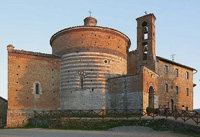 |
||||
Monte Oliveto Maggiore abbey |
Abbey of Sant 'Antimo |
L'eremo di Montesiepi (the Hermitage of Montesiepi) |
||




